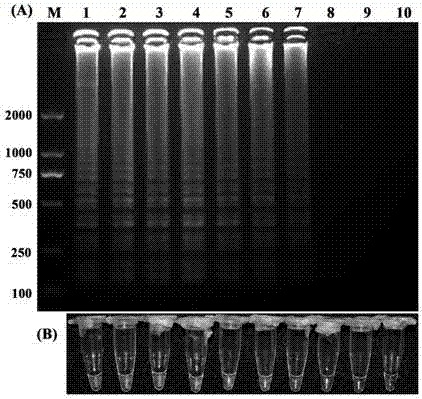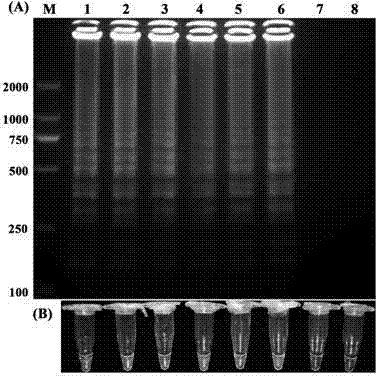Loop-mediated isothermal amplification detection primer for ralstonia solanacearu and detection method for ralstonia solanacearu
A technology for detecting primers and bacterial wilt, which is applied in the fields of identification, prevention and control, and detection of crop diseases, and achieves the effects of good practicability, simple and rapid operation, and high sensitivity.
- Summary
- Abstract
- Description
- Claims
- Application Information
AI Technical Summary
Problems solved by technology
Method used
Image
Examples
Embodiment 1
[0036] Embodiment 1 The present invention is specific to detection of peanut Ralstonia solanacearum
[0037]1. LAMP-specific detection of Ralstonia solanacearum in peanut
[0038] 1) Using R. solanacearum and 25 other strains as test materials, the DNA of R. solanacearum was extracted by CTAB method. The specific method is as follows: inoculate peanut solanacearum in NA liquid medium, culture overnight at 28°C and 200rpm; take 1.5ml culture and centrifuge at 12000rpm for 2min, discard the supernatant, add 567μl TE buffer to resuspend the bacteria, add 30μl 10% SDS solution and 3μl 20mg / ml proteinase K, mix gently, incubate at 37℃ for 1h; add 100μl 5mol / L NaCl solution and mix well, then add 80μl CTAB / NaCl solution, mix and incubate at 65℃ for 10min Add 800 μl of phenol / chloroform / isoamyl alcohol solution (the volume ratio of the three is 25:24:1) and mix well, centrifuge at 12,000 rpm for 5 minutes, take the supernatant, add 0.6-0.8 times the volume of isopropanol, and mix ...
Embodiment 2
[0045] Example 2 Sensitivity detection of the present invention to peanut Ralstonia solanacearum
[0046] 1. LAMP Sensitivity Detection of Ralstonia solanacearum in Peanut
[0047] The extracted R. solanacearum DNA was diluted to 10 ng, 1 ng, 100 pg, 10 pg, 1 pg, 100 fg, 10 fg, 1fg and 100 ag with 9 different concentration gradients by using 10-fold concentration serial dilution method.
[0048] 1. Amplify according to the reaction system and conditions in Example 1;
[0049] ② Add 1 μl of chromogenic agent SYBR green Ⅰ to the final amplification product of the LAMP reaction. If green fluorescence is observed in the color development results, it is judged as positive, and orange is judged as negative. Or take 2 μl of the amplification product and use 2% agarose gel electrophoresis to detect it. If the characteristic trapezoidal band of LAMP appears, it is judged as positive, and if no amplification band appears, it is judged as negative.
[0050] 2. Test results:
[005...
Embodiment 3
[0053] Embodiment 3 The present invention is artificially inoculated to the detection of Ralstonia solanacearum plant tissue
[0054] 1. Detection of Plant Tissues Artificially Inoculated with Ralstonia solanacearum
[0055] Ralstonia solanacearum was inoculated by seed soaking method. Two symptomatic plants and three non-symptomatic plants were randomly selected for detection. Genomic DNA of R. solanacearum was used as a positive control, and healthy peanut plants were used as a negative control. The DNA of peanut Ralstonia solanacearum was extracted by NaOH rapid lysis method.
[0056] Perform LAMP detection as follows:
[0057] 1. Amplify according to the reaction system and conditions in Example 1;
[0058] ② Add 1 μl of chromogenic agent SYBR green Ⅰ to the final amplification product of the LAMP reaction. If green fluorescence is observed in the color development results, it is judged as positive, and orange is judged as negative. Or take 2 μl of the amplification ...
PUM
 Login to View More
Login to View More Abstract
Description
Claims
Application Information
 Login to View More
Login to View More - R&D
- Intellectual Property
- Life Sciences
- Materials
- Tech Scout
- Unparalleled Data Quality
- Higher Quality Content
- 60% Fewer Hallucinations
Browse by: Latest US Patents, China's latest patents, Technical Efficacy Thesaurus, Application Domain, Technology Topic, Popular Technical Reports.
© 2025 PatSnap. All rights reserved.Legal|Privacy policy|Modern Slavery Act Transparency Statement|Sitemap|About US| Contact US: help@patsnap.com



